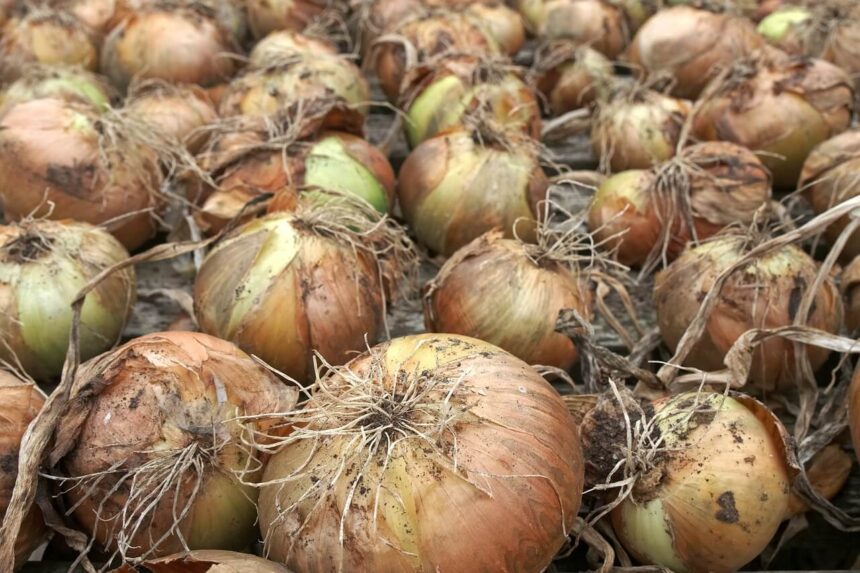Onion farming in Kenya takes place in almost every part of this country.
However, onions thrive the best in the following locations: Makueni County, Kieni, Meru, Karatina, Naivasha, Kajiado, Emali, and Oloitoktok—lastly, Kakamega.
Onions and onion leaves are popular ingredients in everyday cooking. Besides Kachumbari recipes and broth making, onion provides nutritional benefits and vitamins.
Planting, Care, and Harvesting
Onions in Kenya are cultivated on a large scale for commercial purposes and income generation. You, too, can do it on a small scale to cater to your location’s more considerable market demand.
An acre of land can produce between 20-25 tonnes of onions depending on the climatic conditions, type of soil, and onion variety.
Onions thrive in good, well-drained sandy, loamy soils with PH ranges of 6.0 -7.0. The crop prefers a temperate climate between 13 ° and 24 ° C, especially during germination.
The Season for Onion Farming in Kenya
Although for seedlings in the nursery, the recommended temperature is 20 to 27 ° C. High temperatures affect onion production, causing them to dry.
So it is best to grow onions during the cold and wet seasons to be harvested during the dry and hot seasons.
List of Onion Varieties in Kenya
Kenya has two main onion varieties: local and Hybrid varieties.
The varieties are categorized according to their shape, maturity period, and skin color.
The following are varieties of onions grown in Kenya. The seeds are available from Kenya Seed Company starting at Ksh 70 per kilogram, depending on the array.
The local variety of onions in Kenya include
- Red Creole
- Texas Grano
- Bombay Red
While the Hybrid onion variety in Kenya are
- Red Nice F1
- Rasta F1
- Red Coach F1
- Malbec F1
- Red passion F1
- Neptune F1
- Red Connect F1
- Rosa F1
- Ruby F1
- Red Pinoy F1
- Sivan F1
- Jambar F1
The main advantage of the hybrid variety is that it can be grown anywhere. They are also resistant to perennial pests and diseases.
Note: With the advancement of technology, you can apply crop optimizers and chemicals used to kill and control pests and weeds in the soil. Check your local agro vet store for the best type of optimizers.
Onions Nursery bed preparation
Onions are planted on a raised seedbed for germination and later transplanted into the field.
Also, read; Beetroot Farming In Kenya – A Complete Guide.
Therefore, preparing the seedbed two to three weeks before sowing is encouraged. To make your seedbed, proceed as follows;
- Prepare raised seedbeds of 1.2m wide with a length of your choice.
- Add two 20 liters per square of organic fertilizer, mix it with the soil, and rake it evenly.
- Irrigate the raised seedbed one day before sowing seeds.
- Make evenly spread rows of 10-15cm from row to row.
Amount of seeds needed
The seed needed to grow in one square meter is five grams, equivalent to a full teaspoon.
This amount will produce enough seedlings for transplanting to an area of 100 square meters. You only need 2-2.5 kg of seeds for a hectare of land.
Cover the seedbed with mulch, and remember to water the seedbed daily, morning and evening. Onion seeds take approximately 10 -12 days to start germinating.
Field Preparation for Onion Farming
Plow the land one month before transplanting the onion seedlings. Rake the soil to fine particles for two weeks before transplanting the onions.
Next, Incorporate 20 -25 tonnes per hectare of ripe animal manure (Poultry or cow dung) into the field.
This makes the soil rigid and increases moisture retention for an extended period. Mix the organic fertilizer well with the ground, then prepare the furrows you like.
Add the organic manure to every hole during transplanting instead of mixing it with the soil.
Onion Seedlings Transplanting
After six weeks after germination, the seedling should be ready for transplanting. The seedlings should have attained a 12 to 15-cm height by this time.
- To avoid damaging the roots, thoroughly water the seedbed a day before transplanting.
- Use a shovel to uproot the seedlings from the seedbed, and remember to prune the seedling leaves and roots to enhance water retention.
- Plant the seedlings in rows with a 30cm space between rows and 8 to 12cm from one seedling to the other. Onions grown in this position take the shortest time possible to mature early, and the number of onions per area is vast.
Remember to select healthy and pest-free seedlings for transplanting. Very young or very old seedlings are not suitable for transplantation.
It would help transplant the seedlings as deep as they were in the nursery. It would help if you transplanted in the morning or evening to avoid the hot sun and the heat burning the seedlings.
Immediately after transplanting, water the seedlings and then keep watering in the morning and the evening until the seedlings hold well in the soil.
Plantation Maintenance
Like any other crop, onion farming in Kenya must be taken care of after transplanting the seed. Apart from regular irrigation, you must also add fertilizer to the plant.
For weed control, apply any foliar spray mixed with (pesticides, fungicides, insecticides, and herbicides of your choice). This also is as advised by your local agriculture extension officer.
Top Dressing
Apply the growth fertilizer Calcium Ammonium Nitrate (CAN) to the onions during the third and sixth weeks after transplanting.
Use at least three bags per hectare in the third week and four sacks in the sixth week.
It is good to apply fertilizer when the soil is moist enough. A teaspoonful is enough and should be kept inside the rows or near the crop but not touching it.
Irrigation
It is an excellent practice to irrigate your onions in places with less rainfall continuously. Otherwise, onion farming in Kenya is done during the rainy season.
Once the onions start maturing, you must reduce that water for irrigation. Too much water causes onion to rot after growing. You will know that the onions have developed once their leaves turn yellowish.
Lastly, occasionally keep the onion field weed free while adding soil to the plant to cover the roots.
Onion Farming in Kenya: Harvesting.
Your onions will be ready for harvesting after three to five months(90-150 days) from sowing the seeds. This also depends on the variety of the onion and climatic conditions.
A bountiful harvest depends on taking good care of the field during growth, the weather, and the type of onion variety. Properly managed crops can produce 30 to 40 tons of onions per hectare.
Therefore, you should start harvesting the onions when you notice that 50 percent of your crops are weak and dry. Early harvesting causes the onions to spoil early.
When harvesting, prune the entire stem and cut off the excess leaves and roots.
After harvesting, dry the onions in a moisture-free, well-ventilated area. Again, store well-dried onions in a moisture-free, well-ventilated place. Wet onions will rot if you try to keep them.
If the weather is excellent and moist-free, you can store onions for three to six months. You can keep small onions longer than wider varieties.
After harvesting onions, remember to incorporate crop rotation to preserve the soil for the next planting season. This also assists in pest control and diseases.
I hope you enjoyed our post on onion farming in Kenya.







